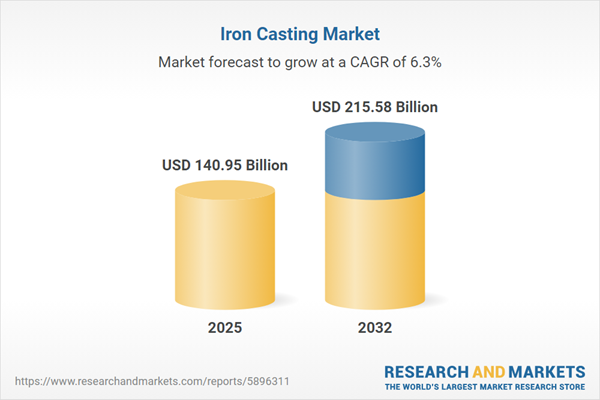Speak directly to the analyst to clarify any post sales queries you may have.
Senior decision-makers responsible for iron casting operations face a fast-evolving marketplace influenced by regulatory changes, technological advancements, and mounting expectations for sustainability. A reliable view of sector trends enables proactive leadership and positions organizations to make informed, competitive decisions in a complex environment.
Market Snapshot: Iron Casting Market Size and Growth Overview
The global iron casting market reached a value of USD 132.62 billion in 2024, sustained by a 6.26% compound annual growth rate. Expansion remains anchored in consistent demand from automotive, construction, and industrial clients. Corporate priorities now include automation, digital manufacturing, and raising efficiency benchmarks to ensure competitiveness and productivity. Market leaders rely on adopting advanced operating models to address changing compliance requirements and make meaningful progress in sustainability. Technology adoption and smart manufacturing investments are strengthening performance and creating new opportunities for iron casting companies worldwide.
Scope & Segmentation of the Iron Casting Market
- Process Types: Die casting, investment casting, and sand casting provide vital options, allowing organizations to align their manufacturing processes with specific performance, quality, and scale needs. These methods enable flexibility for current and future requirements driven by both product specifications and customer expectations.
- Material Types: Ductile iron, gray iron, and malleable iron are chosen for their tailored properties. Selection impacts product lifespan, resistance to wear, and sector compliance, making material choices fundamental for long-term operation and regulatory alignment in diverse industries.
- End-Use Industries: Automotive, construction, and industrial machinery sectors remain principal users. Each industry uses iron casting not just for durability but to comply with evolving performance criteria and regulatory standards. Expansion in industrial applications underscores the versatility and necessity of iron cast components.
- Applications: Engine parts, valves, and pipe fittings are integral to manufacturing and infrastructure. Their proven reliability and adaptability make them prominent in various end-user sectors, responding to increasing infrastructure modernization and specialized production needs.
- Geographical Coverage: The Americas, EMEA, and Asia-Pacific shape global momentum. The United States, Germany, China, and India are particularly dynamic, with regional opportunities driven by investment in technology and resilience. These geographies are seeing growing focus on robust supply chains and modernization, fueling regional differentiation and growth strategies.
- Leading Companies: Nemak S.A.B. de C.V., Georg Fischer AG, Bharat Forge Limited, Linamar Corporation, Aisin Seiki Co., Ltd., Doosan Infracore Co., Ltd., Hitachi, Ltd., Mahindra CIE Automotive Limited, Amtek Auto Limited, and JFE Holdings, Inc. drive sector progress through continuous process upgrades and seamless integration of market and operational demands.
Key Takeaways for Senior Decision-Makers
- Simulation software and real-time analytics are central to precise decision-making, enabling operational teams to maintain efficiency and agility across business functions.
- Ongoing improvements in sustainable metallurgy and recycling practices ensure organizations remain compliant and enhance their environmental profile in a shifting regulatory landscape.
- Adaptive procurement and supply chain management minimize potential disruptions, building resilience and supporting compliance within highly regulated sectors.
- Refinement in material selection and cast production technologies increases product diversity, supporting entry into new market segments and addressing emerging sector needs.
- Collaboration with engineers, manufacturers, and technology providers strengthens development capabilities, accelerating innovation in specialized components and materials.
- Investment in digital skills and the refinement of core processes prepare teams for ongoing technological evolution and continued operational efficiency, supporting sustainability initiatives and strategic positioning.
Tariff Impact: Navigating Policy Shifts and Supply Chain Strategies
Ongoing changes in US tariffs compel iron casting organizations to recalibrate their sourcing and production models. Companies are increasingly strengthening domestic supply networks and investing in localized manufacturing, which can reduce interruptions and improve adaptation to new compliance demands. This trend is shaping supply chain planning and boosting sector responsiveness to evolving international and domestic policies.
Methodology & Data Sources
This research aggregates insights from procurement executives, technical literature, expert interviews, and regulatory records. Subject-matter validation maintains the integrity of the data, meeting rigorous standards essential for decision-making in the iron casting market.
Iron Casting Market: Why This Report Matters
- Equips executive teams to drive digital transformation and modernization, while ensuring alignment with both operational and sustainability goals in casting processes.
- Offers actionable strategies for navigating regulatory frameworks, tariff exposure, and procurement, resulting in more robust forward-planning and management.
- Improves supply chain coordination and resource targeting, empowering organizations to address compliance requirements and satisfy stakeholder considerations.
Conclusion
Senior leaders gain access to timely, actionable market perspectives, supporting resilient decision-making and adaptable strategies in an industry shaped by innovation and evolving regulatory expectations.
Additional Product Information:
- Purchase of this report includes 1 year online access with quarterly updates.
- This report can be updated on request. Please contact our Customer Experience team using the Ask a Question widget on our website.
Table of Contents
3. Executive Summary
4. Market Overview
7. Cumulative Impact of Artificial Intelligence 2025
Companies Mentioned
The companies profiled in this Iron Casting market report include:- Nemak S.A.B. de C.V.
- Georg Fischer AG
- Bharat Forge Limited
- Linamar Corporation
- Aisin Seiki Co., Ltd.
- Doosan Infracore Co., Ltd.
- Hitachi, Ltd.
- Mahindra CIE Automotive Limited
- Amtek Auto Limited
- JFE Holdings, Inc.
Table Information
| Report Attribute | Details |
|---|---|
| No. of Pages | 190 |
| Published | October 2025 |
| Forecast Period | 2025 - 2032 |
| Estimated Market Value ( USD | $ 140.95 Billion |
| Forecasted Market Value ( USD | $ 215.58 Billion |
| Compound Annual Growth Rate | 6.2% |
| Regions Covered | Global |
| No. of Companies Mentioned | 11 |









